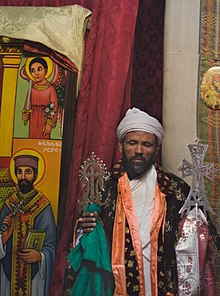Biete Maryam

Biete Maryam is a monolithic rock-cut Ethiopian Orthodox Tewahedo Church in Lalibela, Ethiopia. It is part of the UNESCO World Heritage Site at Lalibela.[1]

Like the other churches of Lalibela, its precise date of construction is unknown, although it was built no earlier than the 7th century AD (during the Kingdom of Axum) and no later than the 13th century AD (during the Solomonic dynasty and Ethiopian Empire).[2] The churches of Lalibela, including Biete Maryam, are traditionally ascribed to having been built during the reign of the Zagwe dynasty ruler Gebre Mesqel Lalibela (r. ca. 1181–1221).[2] Archaeological analyses have discerned that the ruins of defensive fortifications date to roughly the 8th century AD, while the monolithic rock-cut churches were built in two stages: the first from the 11th to early 12th centuries, and the second phase from the late 12th to early 13th centuries.[3]
3D Documentation[]
The Zamani Project spatially documented the rock-hewn churches of Lalibela during four field campaigns between 2005-2009.[4][5] A 3D model of Biete Maryam (House of Miriam/House of Mary) was created. The documentation was carried with the support of the Andrew W Mellon Foundation and in cooperation with the World Monuments Funds. Over 1200 terrestrial laser scans where acquired to generate 3D models of 14 monuments. Panorama tours combining photographic full-dome panoramas and covering all churches were also generated. Textured 3D models, panorama tours, elevations, sections and plans are available on www.zamaniproject.org.
References[]
- ^ UNESCO World Heritage Centre. "Rock-Hewn Churches, Lalibela". unesco.org.
- ^ a b Windmuller-Luna, Kristen (September 2014), "The Rock-hewn Churches of Lalibela", Heilbrunn Timeline of Art History, New York: The Metropolitan Museum of Art, retrieved 27 July 2017
- ^ Phillipson, David (2013), "Complex Societies of the Eritrean/Ethiopian Highlands and their Neighbors", Oxford Handbook of African Archaeology, Oxford: Oxford University Press, p. 811, ISBN 978-0-19-956988-5.
- ^ "Spatial documentation of the rock-hewn churches in Lalibela". zamaniproject.org. Archived from the original on 2019-09-25. Retrieved 2019-09-19.
- ^ "Challenges in Heritage Documentation with Terrestrial Laser Scanning" (PDF). Archived (PDF) from the original on 2019-09-25.
Coordinates: 12°02′01″N 39°02′36″E / 12.03371°N 39.04333°E
- Monolithic churches in Ethiopia
- Buildings and structures in Lalibela
- Ethiopian Orthodox Tewahedo church buildings